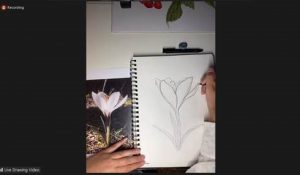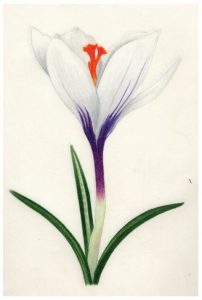Nature is changing around us, whether in the passing of a bud to bloom or climate change. As artists and scientists, we have the ability to observe and document those changes. A few quiet minutes, connecting with nature, can help us explore the beauty of our own backyards. We can develop a sense of time, of place, of change.
Journey through nature journaling

Live drawing lesson during the webinar
Nature journaling allows us to observe details by sketching, recording data, and asking questions. It spans the personal and the scientific, letting the mind wander between stories and questions. It lets us take the time to notice, wonder, and stand in awe at the wildness around us. It is about the journey of noticing rather than arriving at a final destination.
Bridging ecology and creativity
We began on a journey through nature journaling this summer, building a new collaboration between the W.K. Kellogg Bird Sanctuary and the Kalamazoo Institute of Arts, or KIA. Creativity and questioning lie at the heart of both art and science, and we were interested in exploring that intersection where art and science can inspire each other. For our outreach fellowship, we hosted a webinar introducing nature journaling and ecology to a community of artists and naturalists. To our surprise, 115 people from across the world (as far as Beijing!) joined us.
The webinar introduced participants to basic ecological principles and provided a framework for sketching outdoor observations. We began with an Ecology 101 lecture, briefly outlining three scales of ecological study: landscapes, communities, and species. This allowed us to present big picture ideas first: broad patterns of environmental change, conservation, and sustainability. We then narrowed in to examine species interactions at the community level, and finally, individual species at an even finer scale. This process of “zooming in” mirrored a basic tenet of nature journaling: to look not further, but closer.
Once we had laid the groundwork with fundamental ecological concepts, we introduced the audience to the practice of nature journaling as a way to observe those phenomena. We described the layout of a typical nature journaling page and presented examples of diverse journaling styles, emphasizing that the goal of nature journaling is to celebrate the process of observation rather than the perfection of a final product.

Mendoza’s completed crocus drawing.
Participants had an opportunity to put their new journaling knowledge to practice during the latter half of the webinar. Olivia Mendoza, a botanical illustrator at the KIA, led us through a live drawing lesson, sketching the crocus, a common spring wildflower. Olivia broke down the drawing process into six steps: observing, blocking, shaping, refining, detailing, and coloring. These steps made the sketching process accessible and relaxing. One participant shared, “This class helped break the ice to try something I was intimidated to do.” Another asked, “Can we do this every Saturday?” By the end of the sketching process, we were all inspired to continue observing the natural world.
Patience in practice
We initially envisioned our nature journaling program as a three-part, in-person class, but the circumstances of 2020 challenged us to shift the program to a virtual format. Though a webinar was different from the program we’d imagined, we were ultimately able to connect with far more people virtually than we ever would have in person! We plan to continue our nature journaling program next year in 2021, when it may be safer to connect with local artists and naturalists in person. For now, we will cherish the global reach of our virtual webinar and all who were able to experience nature journaling for the first time.
Neither of us started out with knowledge of nature journaling, but the beauty of nature journaling is its capacity for patience and imperfection. As one participant put it, “[This helped] me gain confidence to be imperfect” while nature journaling. Our nature journals should reflect a path of curiosity and discovery and connect us to our own memories and place. They should reflect a path of engagement with the world around us. They should reflect a path of falling in love with nature.
~~~~~~~~~~~~~~~~~~~~
Meredith Zettlemoyer (Lau Lab) and Corinn Rutkoski (Evans Lab) were the KBS Summer 2020 Outreach Fellows. They helped to develop the Nature Journaling program, a collaboration between the W.K. Kellogg Bird Sanctuary and the Kalamazoo Institute of Arts.
~~~~~~~~~~~~~~~~~~~~

A legacy of conservation; a commitment to sustainability.
3700 E. Gull Lake Drive
Hickory Corners, MI 49060
(269) 671-5117
info@kbs.msu.edu